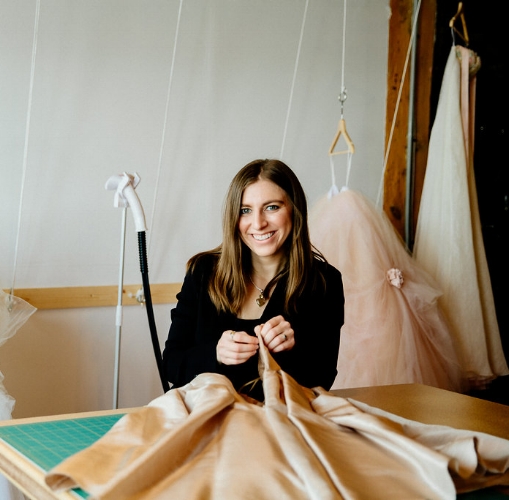Understanding Dress Alterations
So you have a dress, now you need to it to fit right. Finding a tailor you can trust can be a process, especially when you don’t even know what to expect.
When you go get your dress fitted, bring the undergarments and shoes that you will wear with your dress. In order to get the exact fit, you need to have the exact heel height and undergarments for the tailor to measure. If you decide to get a higher heel for the wedding day or event, then your dress will be hemmed too short. If you wear heels for the fitting, then decide to wear flats for the wedding or event, then your dress will be too long and you may risk tripping on it. Bras make a difference, too. Although it is the most supportive, most women prefer not to wear a bra. Bra cups can be sewn into a dress, but the purpose is mostly to add padding and is generally not much support. If you have an open back dress, there are adhesive backless bras to consider. Also, if you need extra fullness to the skirt of your dress, bring the petticoat you plan on wearing with your dress as it could raise the hem of your dress. If you do not have one, ask the tailor if they can add to the dress itself.
So you have everything, now how should the dress fit? No matter how professional the tailor, you need to be able to communicate with them as to how you feel. If the dress does not feel tight enough, let them know. For a strapless, the dress is held up by the waist, not the top, so the dress must fit tight at the waistline. Your chest expands as you breathe and your hips expand as you sit, so the fit should allow for that. Make sure you can take a deep breath in your dress, breathing is important. If the dress is fitted at the hips, make sure you can sit in your dress to make sure it’s not too tight. Even though the dress must be fit at the waist, you should be comfortable in your dress. I always say, if you are comfortable, you will be more beautiful because you will be happy!
The fit of the dress should be addressed before the length because it can affect it. If the dress is too loose and falling down, it will appear longer than when it fits. Length is important because you do not want to carry your dress or risk tripping on it. A wedding gown or formal gown generally is as long as possible without touching the ground, possibly about a quarter to a half inch off the ground. If the dress is really full and puffy, it’s okay to go shorter because your feet still wont show. If your dress has a train, you will need it to have it bustled. A bustle is when the train is hooked up to bring train off the ground and should not be noticeable when the train is down. There are many different ways a bustle can be done so make sure the tailor shows you what it will look like. Bustles can be simple, and bustles can be complex, it all depends on how complicated the dress is. After the alterations are done, I recommend bringing a friend or mom with you so the tailor can show them how your bustle works. For complicated bustles, and nervous friends, taking a video of this lesson of the bustle is not a bad idea.
So be prepared, bring all the things that you need, and communicate with the tailor. At the first fitting, the tailor will do all the pinning and measuring, and at the second fitting the work should be completed. If more needs to be done, there may be another fitting. Ask the tailor if the dress will be steamed and if that will be done before or after the final fitting.

